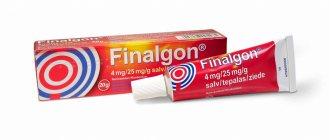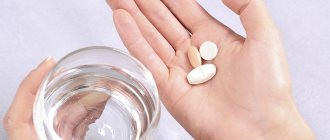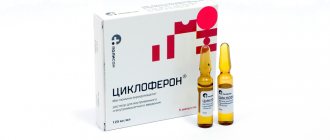Tavegil antiallergic drug, tablets 1 mg N10
A country
Italy
The country of production may vary depending on the batch of goods. Please check with the operator for detailed information when confirming your order.
Description
Tavegil is a first generation antihistamine. The active ingredient is clemastine hydrofumarate *. Available in ampoules and tablets (10 and 20 pieces). * Instructions for medical use, RU P N008878/01 dated 05/31/2010
Compound
Composition per 1 tablet: Active ingredient – 1.340 mg of clemastine hydrofumarate (in terms of 1 mg of clemastine). Excipients: magnesium stearate – 1,200 mg, povidone – 4,000 mg, talc – 5,000 mg, corn starch – 10,800 mg, lactose monohydrate – 107,660 mg.
Product description
Round, flat tablets of white or almost white color with a beveled edge. On one side there are risk tablets and the engraving “OT”.
pharmachologic effect
H1-histamine receptor blocker, belongs to the benzhydryl ether group of antihistamines. It has a strong antihistamine and antipruritic effect with a rapid onset of action and duration of up to 12 hours, prevents the development of vasodilation and contraction of smooth muscles induced by histamine. Possessing an antiallergic effect, it reduces the permeability of blood vessels and capillaries, inhibits exudation and the formation of edema, reduces itching, and has an anticholinergic effect. Absorption After oral administration, clemastine fumarate (clemastine) is almost completely absorbed from the gastrointestinal tract. Maximum plasma concentrations are reached after 2–4 hours. The antihistamine effect of the drug reaches its maximum after 5–7 hours; as a rule, the effect lasts up to 10–12 hours, in some cases up to 24 hours. Distribution: The binding to plasma proteins is 95%. Metabolism Clemastine undergoes significant metabolism in the liver. Excretion Excretion from plasma is biphasic, the corresponding half-lives are 3.6 ± 0.9 hours and 37 ± 16 hours. Metabolites are excreted mainly by the kidneys (45 - 65%); the unchanged active substance is found in the urine only in trace amounts. During breastfeeding, small amounts of clemastine may pass into breast milk.
Indications for use
Hay fever (hay fever, including allergic rhinoconjunctivitis); – Urticaria of various origins; – Itching, pruritic dermatoses; – Acute and chronic eczema, contact dermatitis as an adjuvant therapy; – Drug allergy as an adjuvant therapy; – Insect bites.
Contraindications
Hypersensitivity to clemastine or other ingredients of the drug, as well as to similar antihistamines, - pregnancy, - breastfeeding, - taking monoamine oxidase inhibitors (MAOIs), - diseases of the lower respiratory tract (including bronchial asthma), - porphyria, - childhood up to 6 years (for this dosage form), – lactase deficiency, – lactose intolerance, – glucose-galactose malabsorption; - elderly patients.
Carefully
You should first consult your doctor if you have one of the following diseases/conditions: – Epilepsy or a history of seizures; – Stenosing gastric ulcer, – Pyloroduodenal obstruction, – Bladder neck obstruction, – Prostatic hyperplasia accompanied by urinary retention, – Increased intraocular pressure, – Angle-closure glaucoma, – Hyperthyroidism, – Diseases of the cardiovascular system, including arterial hypertension
Use during pregnancy and lactation
Fertility There are no clinical data on the effects of clemastine on fertility in men and women. Available preclinical data have identified potential adverse effects on male fertility at doses above the clinical oral dose in humans. Pregnancy There are no sufficient data on the use of clemastine in pregnant women. The use of the drug is contraindicated in pregnant women. Breastfeeding Antihistamines may be excreted in breast milk and may affect the baby. Clemastine fumarate is contraindicated for use in nursing women.
Directions for use and doses
For oral administration. Do not exceed the recommended dose! The drug is taken orally before meals with water. Adults and children over 12 years of age: 1 tablet (1 mg) morning and evening. According to the doctor's recommendation, the daily dose can be up to 6 tablets. The maximum single dose should not exceed 2 tablets per dose. Children aged 6 to 12 years: ½ - 1 tablet morning and evening.
Side effect
The following adverse reactions were detected spontaneously during post-registration use of the drug. Adverse reactions are classified according to body systems and according to the frequency of development. The frequency of adverse reactions is determined as follows: very often (≥ 1/10), often (≥ 1/100 and Nervous system disorders: Often: increased fatigue, drowsiness, sedation, weakness, feeling tired, lethargy, poor coordination of movements ; Uncommon: dizziness; Rare: headache, tremor, stimulant effect (usually in children): restlessness, irritability, agitation, nervousness, insomnia, hysteria, euphoria, tremor, convulsions; paresthesia, neuritis. Gastrointestinal disorders : Rare: dyspepsia, nausea, vomiting, gastralgia, dry mouth; Very rare: constipation. Isolated cases of decreased appetite and diarrhea. Visual disorders: Rare: impaired visual clarity, diplopia. Hearing and labyrinth disorders : Rare: acute labyrinthitis, tinnitus Disorders of the kidneys and urinary tract: Very rare: frequent or difficult urination Disorders of the respiratory system, chest and mediastinal organs: Rare: thickening of bronchial secretions and difficulty with sputum discharge, feeling of pressure in the chest, breathing problems, nasal congestion. Disorders of the cardiovascular system: Rarely: decreased blood pressure (more often in elderly patients), extrasystole. Very rare: tachycardia. Blood and lymphatic system disorders: Rare: hemolytic anemia, thrombocytopenia, agranulocytosis. Skin and subcutaneous tissue disorders: Rare: skin rash. Immune system disorders: Rare: hypersensitivity reactions (rash, shortness of breath, anaphylactic shock). If any of the side effects indicated in the instructions get worse, or you notice any other side effects not listed in the instructions, tell your doctor.
Overdose
Symptoms. Overdose of antihistamines can lead to both depressant and stimulant effects on the central nervous system, the latter more often observed in children, for example, decreased level of consciousness, excitability, hallucinations or convulsions. Anticholinergic effects may also develop: dry mouth, fixed dilation of the pupils, “flushes” of blood to the upper half of the body, gastrointestinal disorders (nausea, epigastric pain, vomiting), tachycardia. Treatment. Treatment consists of symptomatic therapy and compliance with the recommendations of specialized medical institutions. If the patient does not vomit spontaneously, then it should be induced artificially (only if the patient’s consciousness is preserved). If 3 hours or a little more have passed since taking the drug, it is necessary to perform gastric lavage using a 0.9% solution of sodium chloride and activated carbon. You can also prescribe a saline laxative.
Interaction with other drugs
The drug enhances the effect of drugs that depress the central nervous system (hypnotics, sedatives, anxiolytics, antidepressants, opioid analgesics), m-anticholinergics, and alcohol. Incompatible with simultaneous use of MAO inhibitors. Since clemastine has anticholinergic activity, the effect of some anticholinergic drugs (eg, atropine, tricyclic antidepressants) may be enhanced.
special instructions
The drug contains lactose monohydrate. Patients with rare hereditary disorders of galactose intolerance, general lactase deficiency or glucose-galactose malabsorption are contraindicated in using this drug. To prevent distortion of the results of skin prick tests for allergens, the drug must be discontinued 72 hours before allergy testing.
Release form
Tablets 1 mg. Primary packaging 10 tablets in a blister made of combined material (PVC/PVDC/Aluminum foil). Secondary packaging 1 blister with instructions for use in a cardboard box.
Storage conditions
At a temperature not higher than 30C. Keep out of the reach of children.
Best before date
3 years. Do not use after the expiration date.
Tavegil antiallergic drug, tablets 1 mg N20
A country
Italy
The country of production may vary depending on the batch of goods. Please check with the operator for detailed information when confirming your order.
Active substance
Clemastine
Description
Tavegil is a first generation antihistamine. The active ingredient is clemastine hydrofumarate *. Available in ampoules and tablets (10 and 20 pieces). * Instructions for medical use, RU P N008878/01 dated 05/31/2010
Compound
Composition per 1 tablet: Active ingredient – 1.340 mg of clemastine hydrofumarate (in terms of 1 mg of clemastine). Excipients: magnesium stearate – 1,200 mg, povidone – 4,000 mg, talc – 5,000 mg, corn starch – 10,800 mg, lactose monohydrate – 107,660 mg.
Product description
Round, flat tablets of white or almost white color with a beveled edge. On one side there are risk tablets and the engraving “OT”.
pharmachologic effect
H1-histamine receptor blocker, belongs to the benzhydryl ether group of antihistamines.
It has a strong antihistamine and antipruritic effect with a rapid onset of action and duration of up to 12 hours, prevents the development of vasodilation and contraction of smooth muscles induced by histamine. Having an antiallergic effect, it reduces the permeability of blood vessels and capillaries, inhibits exudation and the formation of edema, reduces itching, and has an anticholinergic effect. Absorption After oral administration, clemastine fumarate (clemastine) is almost completely absorbed from the gastrointestinal tract. Maximum plasma concentrations are reached after 2–4 hours. The antihistamine effect of the drug reaches its maximum after 5–7 hours; as a rule, the effect lasts up to 10–12 hours, in some cases up to 24 hours. Distribution: The binding to plasma proteins is 95%. Metabolism Clemastine undergoes significant metabolism in the liver. Excretion Excretion from plasma is biphasic, the corresponding half-lives are 3.6 ± 0.9 hours and 37 ± 16 hours. Metabolites are excreted mainly by the kidneys (45 - 65%); the unchanged active substance is found in the urine only in trace amounts. During breastfeeding, small amounts of clemastine may pass into breast milk.
Indications for use
Hay fever (hay fever, including allergic rhinoconjunctivitis); – Urticaria of various origins; – Itching, pruritic dermatoses; – Acute and chronic eczema, contact dermatitis as an adjuvant therapy; – Drug allergy as an adjuvant therapy; – Insect bites.
Contraindications
Hypersensitivity to clemastine or other ingredients of the drug, as well as to similar antihistamines, - pregnancy, - breastfeeding, - taking monoamine oxidase inhibitors (MAOIs), - diseases of the lower respiratory tract (including bronchial asthma), - porphyria, - childhood up to 6 years (for this dosage form), – lactase deficiency, – lactose intolerance, – glucose-galactose malabsorption; - elderly patients.
Carefully
You should first consult your doctor if you have one of the following diseases/conditions: – Epilepsy or a history of seizures; – Stenosing gastric ulcer, – Pyloroduodenal obstruction, – Bladder neck obstruction, – Prostatic hyperplasia accompanied by urinary retention, – Increased intraocular pressure, – Angle-closure glaucoma, – Hyperthyroidism, – Diseases of the cardiovascular system, including arterial hypertension
Use during pregnancy and lactation
Fertility There are no clinical data on the effects of clemastine on fertility in men and women. Available preclinical data have identified potential adverse effects on male fertility at doses above the clinical oral dose in humans. Pregnancy There are no sufficient data on the use of clemastine in pregnant women. The use of the drug is contraindicated in pregnant women. Breastfeeding Antihistamines may be excreted in breast milk and may affect the baby. Clemastine fumarate is contraindicated for use in nursing women.
Directions for use and doses
For oral administration. Do not exceed the recommended dose! The drug is taken orally before meals with water. Adults and children over 12 years of age: 1 tablet (1 mg) morning and evening. According to the doctor's recommendation, the daily dose can be up to 6 tablets. The maximum single dose should not exceed 2 tablets per dose. Children aged 6 to 12 years: ½ - 1 tablet morning and evening.
Side effect
The following adverse reactions were detected spontaneously during post-registration use of the drug. Adverse reactions are classified according to body systems and according to the frequency of development. The frequency of adverse reactions is determined as follows: very often (≥ 1/10), often (≥ 1/100 and Nervous system disorders: Often: increased fatigue, drowsiness, sedation, weakness, feeling tired, lethargy, poor coordination of movements ; Uncommon: dizziness; Rare: headache, tremor, stimulant effect (usually in children): restlessness, irritability, agitation, nervousness, insomnia, hysteria, euphoria, tremor, convulsions; paresthesia, neuritis. Gastrointestinal disorders : Rare: dyspepsia, nausea, vomiting, gastralgia, dry mouth; Very rare: constipation. Isolated cases of decreased appetite and diarrhea. Visual disorders: Rare: impaired visual clarity, diplopia. Hearing and labyrinth disorders : Rare: acute labyrinthitis, tinnitus Disorders of the kidneys and urinary tract: Very rare: frequent or difficult urination Disorders of the respiratory system, chest and mediastinal organs: Rare: thickening of bronchial secretions and difficulty with sputum discharge, feeling of pressure in the chest, breathing problems, nasal congestion. Disorders of the cardiovascular system: Rarely: decreased blood pressure (more often in elderly patients), extrasystole. Very rare: tachycardia. Blood and lymphatic system disorders: Rare: hemolytic anemia, thrombocytopenia, agranulocytosis. Skin and subcutaneous tissue disorders: Rare: skin rash. Immune system disorders: Rare: hypersensitivity reactions (rash, shortness of breath, anaphylactic shock). If any of the side effects indicated in the instructions get worse, or you notice any other side effects not listed in the instructions, tell your doctor.
Overdose
Symptoms. Overdose of antihistamines can lead to both depressant and stimulant effects on the central nervous system, the latter more often observed in children, for example, decreased level of consciousness, excitability, hallucinations or convulsions. Anticholinergic effects may also develop: dry mouth, fixed dilation of the pupils, “flushes” of blood to the upper half of the body, gastrointestinal disorders (nausea, epigastric pain, vomiting), tachycardia. Treatment. Treatment consists of symptomatic therapy and compliance with the recommendations of specialized medical institutions. If the patient does not vomit spontaneously, then it should be induced artificially (only if the patient’s consciousness is preserved). If 3 hours or a little more have passed since taking the drug, it is necessary to perform gastric lavage using a 0.9% solution of sodium chloride and activated carbon. You can also prescribe a saline laxative.
Interaction with other drugs
The drug enhances the effect of drugs that depress the central nervous system (hypnotics, sedatives, anxiolytics, antidepressants, opioid analgesics), m-anticholinergics, and alcohol.
Incompatible with simultaneous use of MAO inhibitors. Since clemastine has anticholinergic activity, the effect of some anticholinergic drugs (eg, atropine, tricyclic antidepressants) may be enhanced. [titleSpecial instructions[/title] The drug contains lactose monohydrate. Patients with rare hereditary disorders of galactose intolerance, general lactase deficiency or glucose-galactose malabsorption are contraindicated in using this drug. To prevent distortion of the results of skin prick tests for allergens, the drug must be discontinued 72 hours before allergy testing.
[titleForm of release[/title] Tablets 1 mg. Primary packaging 10 tablets in a blister made of combined material (PVC/PVDC/Aluminum foil). Secondary packaging 2 blisters with instructions for use in a cardboard box.
[titleStorage conditions[/title] At a temperature not exceeding 30 C. Store out of the reach of children.
Best before date
3 years. Do not use after the expiration date.







